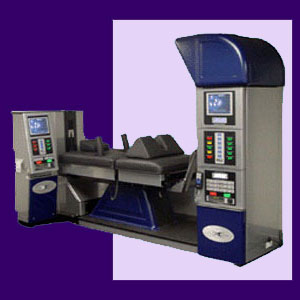
There are numerous spinal decompression risks from surgical approaches but fewer for modern, nonsurgical traction systems, such as the DRX9000, AccuSpina, Antalgic Trak, Hill DT and VAX-D devices. Spinal decompression is one of the most widely used therapies for dorsalgia, since it can effectively treat a wide range of causative conditions throughout the vertebral column.
So many patients write to us inquiring about our advice and experiences with spinal decompression. We were on the front lines of the modern, nonsurgical decompression industry as it was being developed and were the first to spread the truth about the effectiveness of these systems among the general back pain patient population. This essay will continue our quest to keep all readers fully informed of both the good and bad points of decompression therapy, so that they are capable of making more informed decisions when it comes to their own treatment.
This discussion focuses on highlighting the risks and general negative attributes of various forms of spinal decompression therapy. We will examine both surgical and nonsurgical approaches to care that can be used to treat an extensive catalog of spinal diagnoses.
Surgical Decompression Risks
Surgical spinal decompression can involve the use of one or more procedures, depending on the causative nature and location of the neurological compression. Typical techniques include laminectomy, foraminotomy, discectomy and corpectomy. Spinal fusion is a common add-on procedure to all of these surgical practices.
Surgical decompression is always incredibly risky for many reasons. The procedure(s) will demonstrate many general health risks due to anesthetic, infection, the possibility of nerve damage, the possibility for excessive or continuing bleeding or the possibility for spinal fluid leakage. Procedural specific risks are also substantial, with each individual surgical approach demonstrating many specific dangers and negative consequences to the patient.
There is a sizeable chance that procedures will fail to successfully accomplish the surgical goal of actually decompressing the nerve tissue. Sometimes, the surgeon simply commits procedural errors, while other times, scar tissue or other factors might spoil the results. Regardless, failed spinal surgery is common among patients who seek invasive decompression care.
However, one of the major risks that is usually not considered is the moderate to high likelihood for misdiagnosis (depending on the nature of the diagnosis), statistically present in cases of theorized nerve compression and the low to moderate risk of misdiagnosis present in cases of theorized spinal cord compression. If the diagnosis is not accurate, then even if the procedure goes perfectly, relief will not be achieved. Think of the horror of undergoing such a terrible surgical ordeal and having permanent trauma committed against your spine without any benefit to be gained. This is the reality faced by a significant percentage of patients who undergo surgical intervention for nerve compression diagnoses each year.
More information on all the procedural options for surgical decompression can be found in our comprehensive back surgery resource section.
Nonsurgical Spinal Decompression Risks
Nonsurgical spinal decompression, such as that offered by the VAX-D, DRX9000, AccuSpina, Antalgic Trak and Hill DT systems demonstrate far fewer and less significant risks for indicated patients. However, these systems are also only effectual for treating tightly defined circumstances that may involve nerve or spinal cord compression.
Nonsurgical decompression therapy is best utilized for herniated disc diagnoses wherein the disc is thought to be compressing a nerve or the spinal cord. Decompression is slightly less effective for diagnoses in which degenerative disc disease is theorized to be a primary cause of foraminal narrowing or central vertebral canal narrowing, leading to subsequent neurological impingement. Nonsurgical decompression is the least indicated for cases of facet joint arthritis and general spinal age-related changes that might be contributory to a reduction in foraminal patency and possible nerve root compression.
For indicated patients, nonsurgical decompression is thought to be generally safe. Here have been reports or pain and some litigation based on theorized injury sustained during nonsurgical decompression. However, most cases are not clearly defined if injury actually occurred and if so, was the decompression therapy to blame.
Nonsurgical decompression is known to be potentially dangerous for specific case profiles, including patients with a history of spinal fusion or certain other types of spinal operations or implants, patients with severe abnormal spinal curvatures, such as hyperlordosis, hyperkyphosis and scoliosis, patients suffering from spondylolisthesis, patients with a history of specific types of vertebral fractures, patients who suffer from osteoporosis, osteopenia or compression fractures and patients with a variety of diseases and general health disorders. This is why all patients considering decompression using nonsurgical means must be carefully screened prior to treatment.
Spinal Decompression Risks Analysis
All forms of decompression therapy can be effective for treating the diagnoses they are designed to act upon. However, nonsurgical methods of decompression are by far safer and statistically just as effective, if not more so, than surgical methods of care for identical diagnoses.
For disc-related decompression, we virtually always recommend nonsurgical spinal decompression, as these systems are safe, effective and ideal for treating degenerated, bulging and herniated disc conditions. For facet joint pain and general age-related decompression needs, nonsurgical spinal decompression still has an edge due to safety reasons. However, for most forms of central spinal stenosis and some forms of foraminal stenosis, such as those enacted by internal arthritic processes within the foramina, surgical decompression is the only curative option available. This is also the case for patients suffering from nerve impingement due to spinal curvature, vertebral migration, displaced fracture and many other case-specific circumstances.
The bottom line comes down to this… If nonsurgical decompression is indicated, then pursue it ahead of any surgical care. If not, then consider surgical decompression against the idea of ongoing symptomatic care. However, regardless of the circumstances, just be absolutely sure that the diagnosis is accurate or else face failure of whatever type of treatment you choose. This is our most important piece of advice.
Back Pain > Spinal Decompression > Spinal Decompression Risks





